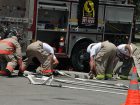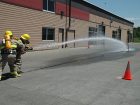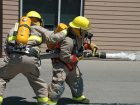
Features
Training
Trainer’s Corner: August 2015
I really enjoy training the members of Greenwood Fire and Rescue in British Columbia. I also enjoy the fact we are a volunteer department; it gives me a lot of leeway when it comes to practice nights.
July 16, 2015
By Ed Brouwer
Our department is pushing toward excellence. We have set a high professional standard of training and we desire our performance on the fire ground to be outstanding. The one downfall with these lofty goals is that it is easy to forget to have fun along the way. To keep the fun in training, I try to mix it up, so to speak, with a good balance of engaging scenarios. What I mean by that is training scenarios that engage each member and each member’s thought process.
One way I keep the fun in training is by disguising training reviews in PowerPoint games such as Jeopardy. Our attendance levels are consistently high, in part, due to the fact members never know what to expect; they don’t want to miss out.
I created a scenario for our hose lays and pump operations training; I disguised the training in a Survivor-type challenge. I will assume you already know the various lays and loads but if you need background on hose lays, go to www.firefightingincanada.com, click on training and read past issues of Back to Basics by Mark van der Feyst.
My objectives for this training were two-fold: first, to familiarize each member with the procedures for engaging and disengaging the pumps on our two engines; second, to train members on how to deploy and reload our preconnect, remove a length and add a length of hose, charge the line and use a nozzle.
Our preconnect is a minuteman load – a variation of the flat load. The minuteman load can be deployed from the nozzle person’s shoulder as it is advanced.
Survivor Challenge preparation (your prep may differ):
- Place two engines next to each other approximately 4.5 metres (15 feet) apart. Find a location at which firefighters can stretch out 76 metres (250 feet) of hose safely. Place a staging tarp 15 metres (50 feet) behind each engine (this is where teams wait for their turn). Place a traffic cone 7.6 metres (25 feet) further than the length of your preconnect (this will be used during the charged hose task).
- Choose two officers – preferably ones who are very familiar with the engine pumps – and assign one to each truck. The officers will monitor the members as they perform their tasks.
- Divide the remaining members into two teams and assign each one to a staging mat. After explaining the first task and giving the teams a minute to strategize, begin task one.
The challenge:
Task one is engaging and disengaging the pump. Each member must (one at a time) leave the staging tarp and engage the pump. Once the officer is satisfied, the member must then disengage the pump. Once the task is completed the member returns to the staging mat and the next teammate has a go. The relay continues until the entire team is through.
Task two: using the minuteman. Explain the second task and give the teams a minute to strategize. Note: no one member may do two tasks in a row.
- Two team members pull a minuteman from their assigned engine, stretching out the hose toward a traffic cone (marked for their team). Once the hose is stretched out, the firefighters call for water, burp the line, and then must knock over the cone. Once the cone is down, the members radio the pump operator (one of the two officers), shut down the water, lay down the hose and return to the team mat.
- The next two members go to the hoseline and safely remove one length of hose and reconnect the now-shortened line. They call for water and charge the line. Once the line is charged they burp it and call for water to be shut down. They lay down the hoseline and return to the mat.
- The next two members go to the hoseline and properly reattach the length of hose that was previously removed. Once completed, they ask for the hoseline to be charged, burp the line and radio to shut the line down. After laying down the line they return to their mat.
- The next two members go to the line, call for water and using the hose stream push the reset traffic cone down. Once the cone is down, they call for the water to be shut down, lay down the nozzle and return to the mat. Once they return to the mat the entire team works together to drain and properly lay the minuteman back in the hose bed.
Once all tasks are completed properly, the first team back on the mat is declared the winner!
Actually, everyone wins because after all is said and done it was a great practice. Competing as a team builds cohesion. And there is more to group cohesion than you might think.
I have noticed over the years that departments that have group cohesion have fewer safety issues, fewer human resource issues and collectively enjoy a sense of personal satisfaction for a job well done. Cohesion in the department creates a healthy working and learning environment, which, in turn, leads to better individual performances.
I hope you have fun trying this exercise with your department. If you have any ideas along these lines, shoot me an email; I’d love to try them.
Until next time – remember to train as if lives depend on it, because they do.
Ed Brouwer is the chief instructor for Canwest Fire in Osoyoos, B.C., and training officer for Greenwood Fire and Rescue. He is also a fire warden with the B.C. Ministry of Forests, a wildland urban interface fire-suppression instructor/evaluator and an ordained disaster-response chaplain. Ed has written the Trainer’s Corner for 13 of his 26 years in the fire service. Contact Ed at ebrouwer@canwestfire.org
Print this page


